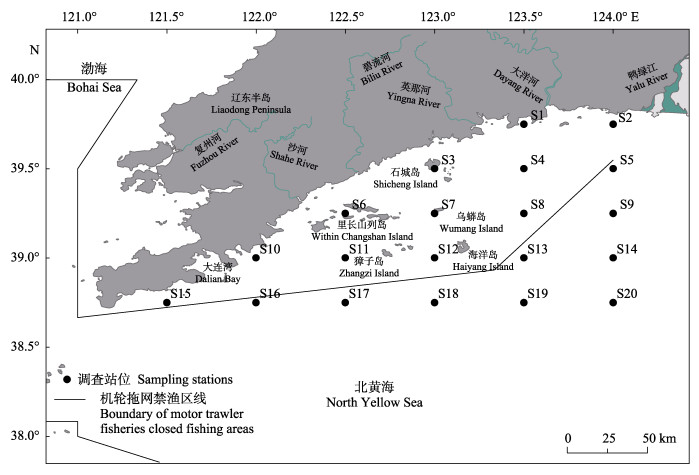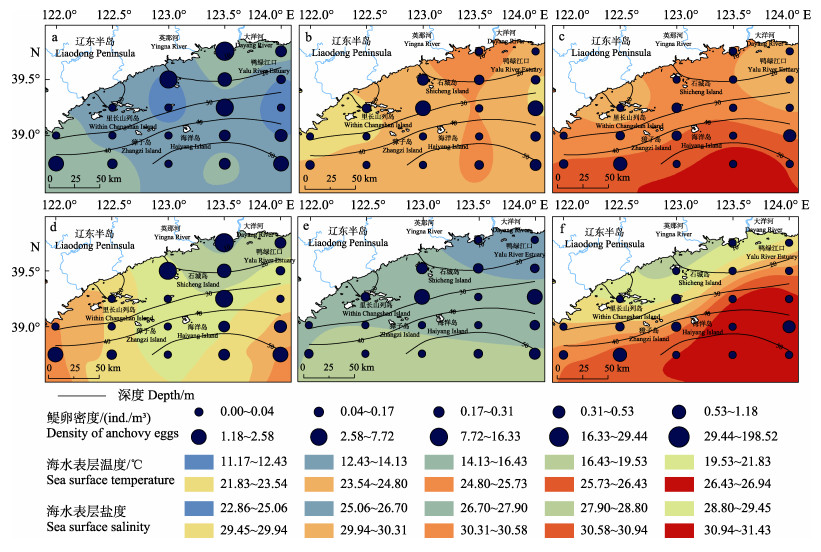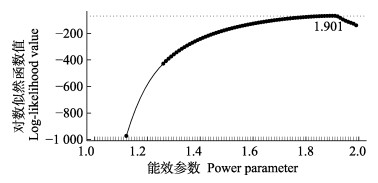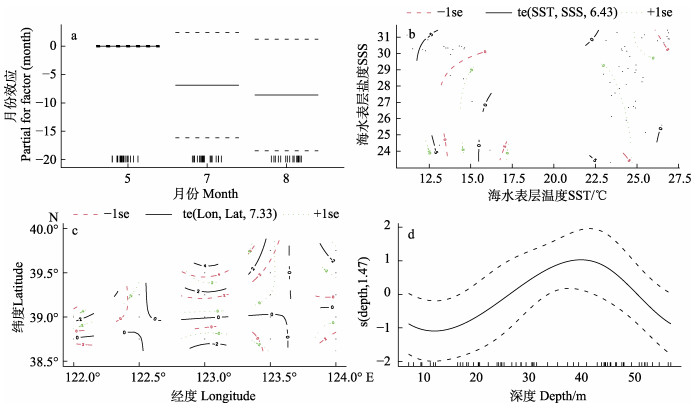2. 山东长岛近海渔业资源国家野外科学观测研究站 山东 烟台 265800;
3. 上海海洋大学海洋科学学院 上海 201306
2. National Field Observation and Research Center for Fisheries Resources in Changdao Waters, Yantai 265800, China;
3. College of Marine Sciences, Shanghai Ocean University, Shanghai 201306, China
鳀(Engraulis japonicus)隶属于鲱形目(Clupeiformes)、鳀科(Engraulidae)、鳀属(Engraulis),是一种近海集群性强、生命周期短的小型中上层鱼类(张春霖等, 1955),广泛分布于中国的渤海、黄海和东海以及朝鲜、韩国、日本、俄罗斯远东水域(Whitehead et al, 1988; 李显森等, 2006)。鳀在黄海繁殖期较长,一般在4—10月间,并伴有洄游行为,于每年3—4月由黄海南部越冬场北上,4月底或5月初到达黄渤近海各产卵场,此后边产卵边索饵(李富国, 1987; 陈大刚, 1991)。鳀作为数量巨大的小型中上层鱼类及主要饵料鱼种,在黄海生态系统中起着承上启下的枢纽作用,是黄海生态系统动力学研究的关键种(唐启升等, 2000)。黄海北部辽宁近岸海域处于海洋与陆地交汇地带,兼有海、陆两种不同属性的环境特征,受各种自然营力作用和人类活动影响深刻,且沿岸有鸭绿江、大洋河、英那河等诸多河流入海,自然环境的复杂性和多变性较为突出(程济生等, 2004),曾是黄海北部的重要产卵场和重要的渔业水域(刘效舜等, 1990; 陈钰, 2002; 程济生等, 2004; 王年斌等, 2004; 刘修泽等, 2014)。海域内大洋河口至海洋岛北部及海洋岛东南部邻近海域为已探明的鳀在黄海重要产卵场(阮洪超等, 1984; 万瑞景等, 1998)。
在海洋生态系统中,鱼类早期补充群体的丰歉直接影响了种群补充成功率,进而决定着世代的强弱(Henk et al, 1990; 万瑞景, 2016)。其资源分布与变化不仅反映产卵场动态,而且对维持海洋生态系统平衡起着重要作用。鳀卵发生量则是衡量鳀生殖群体生产力及资源补充的基础(王爱勇等, 2010)。国内相关鳀早期生活史研究已有鳀早期发育形态(阮洪超, 1984; 江素菲等, 1984)、产卵场(阮洪超, 1984; 万瑞景等; 2008a; 于金珍等, 2020; 卞晓东等, 2022)、产卵期和产卵条件(万瑞景等, 2008b; 于金珍等, 2020; 卞晓东, 2022)、巨大捕捞压力下鳀卵子大小及自然死亡率动态(Wan et al, 2012)和摄食生态(孟田湘, 2001)等。与黄海北部辽宁近岸海域鳀早期资源状况相关的研究包括1959年12航次黄渤海鳀卵及仔稚鱼逐月调查(阮洪超, 1984)、1985年3月—1986年10月13航次黄海渔业生态系试捕调查(万瑞景等, 1998)、1987和1988年5—6月3航次黄海近岸产卵场调查(万瑞景等, 1998)、1998年6—9月2航次黄海北部近岸水域生物资源及栖息环境调查(程济生等, 2004)、1998年5月—2000年12月5航次黄渤海海洋生物资源及其环境调查(金显仕等, 2005)、2009年5—10月4航次黄海北部近岸鱼卵仔鱼专项调查(于旭光等, 2020)、2009—2010年4航次黄渤海重点水域增殖生态基础调查(金显仕等, 2014)以及2014—2017年黄海北部辽宁近岸产卵场普查(董婧等, 2018)等数次调查。鱼卵阶段是鱼类生命周期中死亡率最高的时期(殷名称, 1991),也是对海洋环境变化极为敏感的时期,海洋环境的细微变化将对其存活、发育和生长产生强烈影响(Perry et al, 2005; 万瑞景等, 2016)。黄海北部辽宁近岸海域作为重要的产卵场及索饵场,海域地处暖温带且海陆交互频繁,气候复杂多变,在人类活动和气候变化双重扰动下,鱼类早期资源分布易呈现剧烈波动,而上述研究除阮洪超(1984)和万瑞景等(1998)对黄海北部辽宁近岸海域鳀主产卵期、适温适盐特性、产卵场分布及其生态特征等方面做过详细阐述外,多数研究仅限于鳀早期资源数量分布状况的描述,而有关其产卵场分布与关键环境因子的研究则相对较少。另外,鱼类早期资源作为资源补充源头,是产卵场调查和评价重要组成部分,摸清其产卵场分布特征及环境驱动因子有助于评估海域鱼类资源现状和发展趋势,为渔业资源合理开发利用及产卵场保护策略研究提供重要参考。
鱼类早期资源密度分布与环境之间的关系非常复杂,具有非线性和不可累加的特性(Stenseth et al, 2002; Dingsr et al, 2007)。广义可加模型(generalized additive model, GAM) (Hastie et al, 1986)是渔业中用来分析资源数量分布与环境因子之间关系的常用方法(陈新军等, 2007; 张云雷等, 2019; 朱文斌, 2021),相较于传统方法,其以平滑函数探究响应变量与解释变量之间的非线性关系和每个因子的重要程度,限制条件少,运用更灵活(Piet, 2002; 薛毅等, 2007; 马稳等, 2022)。另外,在产卵场调查中,因鱼卵在自然水域非均匀分布,密度数据常不具备正态性,且存在相当比例的零值(卞晓东等, 2022; 张雨轩等, 2022),应用一般GAM方法不能很好地反映鱼卵分布与环境因子之间的关系(尹洁等, 2019),诸多应用表明,对于样本零值比例较高且呈偏态分布的资源数据而言,基于Tweedie分布的GAM (Tweedie-GAM)较适合(王浩展等, 2017; 张云雷等, 2019; 万荣等, 2020a、b; 张雨轩等, 2022; 马稳等, 2023)。因此,本研究基于2021年4—12月在黄海北部近岸海域开展的逐月产卵场调查获取的鳀卵和同步获取的环境因子数据以及时间和空间因子数据,应用Tweedie-GAM模型分析方法研究影响鳀卵分布的关键因子,以期阐明海域鳀产卵场分布特征及其影响因素,为黄海北部辽宁近岸海域鳀产卵场保护和管理提供生态学参数。
1 材料与方法 1.1 调查方法及样品处理2021年4—12月(具体时间为4月18—21日、5月28日—6月1日、7月21—24日、8月17—20日、9月11—14日、10月31日—11月4日、12月11—13日)于黄海北部辽宁近海海域开展7航次产卵场综合调查,调查船为“中渔科102”,调查区域为38.75°~39.75°N,121.5°~124°E,站位布设如图 1所示,其中,4—11月S15站未调查,12月S3和S6站未调查。调查内容包含鱼卵和仔稚鱼、基础饵料生物(浮游动植物)、基本环境要素(表、底层水温SST/SBT,表、底层盐度SSS/SBS,深度Depth,表层叶绿素浓度Chla)。

|
图 1 2021年黄海北部辽宁近岸海域产卵场调查站位 Fig.1 Stations of spawning grounds survey in offshore waters of the Liaoning Province in the North Yellow Sea in 2021 |
海上作业流程及样品分析参照《海洋调查规范第6部分:海洋生物调查》(GB/T 12763.6-2007)。鱼卵、仔稚鱼样品的采集使用网目直径为0.505 mm筛绢制成的口径80 cm、长270 cm的大型浮游生物网,各站表层水平拖网10 min,拖速预设为2.0 n mile/h,网口系流量计记录滤水体积。采集的样品以5%海水甲醛溶液固定保存,实验室内对其进行分拣,样品全样本分析,使用生物解剖镜对分拣后标本进行种类鉴定和个体计数;海水温度、盐度使用美国Seabird 19 plus或德国Sea & Sun Technology CTD60M温盐深仪现场测量,选取海水表层0.5 m内的平均值作为海表温、盐数据;水深为船载声呐同步实测数值;叶绿素浓度是通过采水器采取500 mL表层海水并过滤至玻璃纤维滤膜(孔径0.7 μm),冷冻保存带回后,实验室内以90%丙酮溶液于–20 ℃环境下冷冻萃取12 h,使用Turner Designs Trilogy仪器测定。浮游动、植物分别采用浅水Ⅱ型网(网口内径0.316 m,网目孔径0.160 mm)和浅水Ⅲ型网(网口内径0.370 m,网目孔径0.070 mm)沿海水底层垂直向上采集,采用传统形态学分类方法对其进行分析。
1.2 鳀卵数据标准化处理以滤水体积对各站采集的鳀卵数量进行标准化,滤水距离根据网口流量计计算:
| $ V = d \times \pi {r^2} = (R \times q) \times \pi {r^2} $ | (1) |
| $ \rho = \frac{N}{V} $ | (2) |
式中,V为每站水平拖网滤水体积,d为每站水平拖网滤水距离(m);R为拖网的流量计转数差值(round);q为网口流量计的距离转数比(m/round),r为大型浮游生物水平拖网的网口半径(m),ρ为鱼卵密度(ind./m3),N为鱼卵数量。
1.3 产卵重心分布及环境因子梯度采用Garrison的分布重心法(都煜等, 2017)计算各月鳀产卵重心,并研究产卵重心迁移趋势:
| $ X=\frac{{\displaystyle \sum _{i=1}^{n}({X}_{i}\times {\rho }_{i})}}{{\displaystyle \sum _{i=1}^{n}{\rho }_{i}}} $ | (3) |
| $ Y = \frac{{\sum\limits_{i = 1}^n {({Y_i} \times {\rho _i})} }}{{\sum\limits_{i = 1}^n {{\rho _i}} }} $ | (4) |
式中,X、Y分别为产卵重心的经度、纬度,Xi、Yi分别为i站位的经度、纬度,
为探究4—12月海域自然环境概况,分别构建海水表层温度(sea surface temperature, SST)、海水表层盐度(sea surface salinity, SSS)、海水表层叶绿素浓度(Chla)和深度(Depth) 4个自然环境变量与月份(Month)时间变量和经纬度(Lon, Lat)交互空间变量的一般GAM,GAM的一般形式为(万荣等, 2020a):
| $ \text{g}(Y)=\alpha+{\displaystyle }\sum\limits_{i=1}^{n}{f}_{i}({x}_{i})+\epsilon $ | (5) |
式中,Y为响应变量,g(Y)为联系函数,xi为第i个解释变量,fi (xi)为平滑函数,α为截距,ε为残差。
1.4 Tweedie-GAM构建过程以2021年主产卵期(5—8月)鳀卵密度数据(ρ, ind./m3)作为响应变量。根据鳀卵密度频数分布判断其分布类型,并利用R语言tweedie程序包tweedie. Profile()函数确定鳀卵密度ρ在能效参数p为何值时取得最大对数似然函数值(Dunn et al, 2008)。当p=0、1、2、3时,分别对应正态分布、泊松分布、伽马分布和逆正态分布;当1<p<2时,Tweedie模型为复合泊松分布(Tweedie, 1984),Tweedie分布的概率密度函数为(Shono, 2008b; 万荣等, 2020a):
| $ f(y:\theta, \;\phi, \;p)\; = \;\alpha (y:\;\phi, \;p)\exp \left\{ { - \frac{1}{{2{\sigma ^2}}}d(y:\;\theta, \;p)} \right\} $ | (6) |
式中,θ为位置参数,φ为分散参数,p为能效参数;σ为标准差,d(y: θ, p)为单位偏差。P可以定义为除0<P<1外的任意实数。
选取鳀主产卵期内同步环境调查数据为预选解释变量,包括SST、SSS、Chla和Depth 4个自然环境变量,(SST, SSS) 1个交互环境变量,浮游动物丰度(Fd)和浮游植物丰度(Fz) 2个生物环境变量,(Lon, Lat) 1个交互空间变量和Month 1个时间变量。为减少多重共线性问题对模型准确性的干扰,本研究通过计算方差膨胀因子(VIF,阈值设定为4) (Kabacoff, 2015)和条件数(κ, 阈值设定为100) (薛毅等, 2007)衡量预选解释变量多重共线性的程度。
若响应变量符合Tweedie分布,在筛选解释变量后,采用逐步回归分析构建Tweedie-GAM,综合AIC (Akaike information criterion) (Mugo et al, 2010)和偏差解释率(deviance explained, DE) (薛毅等, 2007)评价所建模型优良性,AIC最低且DE最高的模型为最优。模型构建使用R语言mgcv程序包(Wood, 2006),所建Tweedie-GAM模型如下(张雨轩等, 2022):
| $ \left\{ \begin{array}{l} \rho \sim T{w_p}(\theta, \varphi) \hfill \\ \mu = E(\rho) \hfill \\ {\text{ln}}(\mu) = \alpha + \mathop \sum \limits_{i = 1}^n {f_i}({x_i})+ \varepsilon \hfill \\ \end{array} \right. $ | (7) |
式中,ρ为鳀卵密度(ind./m3),θ为位置参数,φ为分散参数,p为能效参数;μ为鳀卵密度ρ的期望值,即E(ρ);ln(μ)表示联系函数为自然对数,α为截距,ε为残差,xi为解释变量,fi(xi)表示第i个变量的非参数平滑函数。
1.5 模型验证及潜在产卵场预测应用5折交叉验证对所建Tweedie-GAM模型的预测能力和准确性进行评价,将总数据集随机等分为5个子集,每次随机选择其中4个子集作为训练集,剩余1个子集作为验证集,整个过程重复次100次,并通过构建模型预测值y*与实际观测值y之间的线性关系来描述二者之间的近似程度(Li et al, 2015; 马稳等, 2022; 孙浩奇等, 2022):
| $ y = a+ b \times {y^*} $ | (8) |
式中,截距a和斜率b的均值反映了模型预测能力,a=0代表预测值与实际观测值具有相似的空间特征,b=1代表模型预测无系统偏差。同时计算决定系数(R2)平均值作为回归方程的拟合优度(Li et al, 2015)。
依据2021年5、7、8月海表月平均温度(1/12°×1/12°)及海域平均深度数据(1/12°×1/12°),基于所建Tweedie-GAM模型对海域鳀卵分布进行预测,以此分析海域鳀潜在产卵场所。海表温度数据由哥白尼海洋环境监测服务中心(Copernicus Marine Environment Monitoring Service, CMEMS)提供(https://marine.copernicus.eu/),深度数据来自GMED全球海洋环境数据集(https://gmed.auckland.ac.nz/download.html)。
2 结果与分析 2.1 2021年黄海北部辽宁近岸海域鳀卵密度分布2021年4—12月于黄海北部辽宁近岸海域开展的7航次产卵场调查共采集鳀卵61 452粒,其中,4月23粒,平均密度为2.3×10–3 ind./m3,出现频率为5.26%;5—6月54 123粒,平均密度为13.81 ind./m3,出现频率为100%;7月5 486粒,平均密度为0.90 ind./m3,出现频率为89.47%;8月1 711粒,平均密度为0.20 ind./m3,出现频率为52.63%;9月108粒,平均密度为0.014 ind./m3,出现频率为36.84%;10—11月1粒,平均密度为9.96×10–5 ind./m3,出现频率为5.26%;12月未采集到鳀卵(图 2)。5—8月各月鳀卵平均密度相对较高,出现频次均在50%以上,为鳀在海域内的主产卵期。5—6月集中分布在大洋河口至石城岛及海洋岛一带海域;7月大洋河河口及里长山列岛西南海域均未采集到鳀卵,整体资源密度有明显下降,鳀卵分布逐渐远离近岸向调查海区中部迁移;8月鳀卵分布进一步南移,主要分布于獐子岛周边及鸭绿江南部外海海域,鸭绿江口及大洋河口站位未采集到鳀卵(图 2)。

|
图 2 2021年4—11月黄海北部辽宁近岸海域鳀卵密度分布 Fig.2 Density distribution of Engraulis japonicus eggs in offshore waters of the Liaoning Province in the North Yellow Sea from April to November 2021 a:4月;b:5—6月;c:7月;d:8月;e:9月;f:10—11月 a: April; b: May to June; c: July; d: August; e: September; f: October to November |
图 3a、b、c为2021年5—8月鳀卵密度与SST分布图,5—8月是黄海北部辽宁近岸海域SST升温期,平均SST由5—6月的13.6 ℃升至7月的24.2 ℃和8月的25.4 ℃。5—6月,海域内大洋河河口及大连湾东部海域为相对SST高值区,鳀卵在此处分布最为密集;而相对SST较低的乌蟒岛、石城岛及鸭绿江口南端30~40 m等深线附近海域鳀卵分布则较为稀疏(图 3a)。7月,鳀卵主要分布于SST 23.5~24.8 ℃、Depth 30~40 m等深线范围内海域(图 3b)。8月,鳀卵分布区已南移至Depth 40~50 m外海,而其所处海域SST高达25.7~26.4 ℃。

|
图 3 2021年5—8月鳀卵密度及各环境因子实际分布 Fig.3 Density of Engraulis japonicus eggs and distribution of environmental factors from May to August 2021 a:5—6月SST;b:7月SST;c:8月SST;d:5—6月SSS;e:7月SSS;f:8月SSS。 a: SST from May to June; b: SST in July; c: SST in August; d: SSS from May to June; e: SSS in July; f: SSS in August. |
图 3d、e、f为鳀卵密度与海水表层盐度分布图,5—8月黄海北部辽宁近岸海域SSS皆呈现由近岸向离岸外海逐渐升高的趋势。5—6月,高SSS区位于海域东南及西南外侧深水区,自大洋河和英那河口存在一个突入调查水域的低盐水舌(图 3d);7月,海域整体SSS有着明显下降,较高SSS区域基本位于Depth 40 m等深线以南海域(图 3e);8月,SSS整体有所回升,高盐区仍位于海域东南侧外海(图 3f)。
2.3 黄海北部辽宁近岸海域鳀产卵重心月度分布与海域环境因子梯度黄海北部辽宁近海鳀产卵重心有明显月度变动趋势(图 4a),4月下旬至6月上旬,产卵重心由海洋岛东南部外侧深水区(123.5°E,38.75°N)迁移至大洋河河口近岸海域(123.45°E,39.62°N),7月后产卵重心开始向离岸深水区迁移。7月下旬至11月上旬,产卵重心进一步向调查海域西南侧深水区迁移,10月下旬至11月上旬鳀产卵重心迁移至海洋岛西南部外侧深水区(122.5°E,38.75°N),与4月下旬大致相同纬度。最终于12月中旬产卵重心消失。

|
图 4 2021年黄海北部辽宁近岸海域鳀产卵重心月度分布(a)及海域环境环境因子梯度(b: SST; c: Chla; d: SSS; e: Depth) Fig.4 Monthly distribution of spawning center of Engraulis japonicus (a) and sea environmental gradient (b: SST; c: Chla; d: SSS; e: Depth) in offshore waters of the Liaoning Province in the North Yellow Sea in 2021 |
海域自然环境要素的梯度变化:SST(图 4b)、SSS (图 4d)和Depth (图 4e)梯度变化趋势相似,皆自近岸端向远岸侧呈递增趋势,整体梯度变化较为均匀。Chla (图 4c)有自近岸端向远岸端逐步递减趋势,其在海区东侧近岸端梯度变化明显,自此向南及西南部外海海域梯度变化相对放缓。
2.4 Tweedie-GAM模型构建及分析选取5—8月主产卵期内鳀卵密度数据作为响应变量,依其频数分布判断该数据呈明显偏态分布并存在一定比例0值(约19%),经tweedie. Profile()函数确定其在能效参数p=1.901时取得最大对数似然函数值(图 5),得出该数据分布类型为复合泊松分布,因此,选用Tweedie-GAM。

|
图 5 改变能效参数p时的对数似然函数值 Fig.5 Log-likelihood function value while changing the power-parameter |
将VIF<4且θ<100的解释变量(除SST外其他因子)与鳀卵密度进行单因子GAM检验从而获得统计学上有意义的影响因子,由表 1可知,(Lon, Lat)、(SST, SSS)和Fd与鳀卵密度在P<0.001水平上显著相关,Depth、Chla和Fz在P<0.01水平上显著相关,SSS在P<0.05水平上显著相关,各因子皆与鳀卵密度表现出较好的相关性。综合AIC和偏差解释率及调整后的R2可知,Fz的AIC值相对较高、偏差解释率相对较低且调整后的R2为负,因此,筛除该变量。
|
|
表 1 单因子GAM检验所得AIC、偏差解释率、R2及P值 Tab.1 AIC, deviance explained, R2 and P-value obtained by single factor GAM test |
对筛选后剩余的解释变量与鳀卵密度进行逐步回归构建Tweedie-GAM模型,结果见表 2,其中,时间因子Month视为固定因子。综合AIC和累积偏差解释率分析可知,factor(Month)+(SST, SSS)+Depth+(Lon, Lat)为最优模型,该模型AIC为97.47,累积偏差解释率达71.8%,其中,Month的偏差解释率最高(28.3%),其次为(Lon, Lat) (19.8%)、(SST, SSS) (18.7%)和Depth (5%),除时空因素外,SST与SSS的交互作用是所选自然环境变量中影响鳀卵密度最为主要的因子。具体表达式为:
| $ \begin{gathered} {\text{g}}(\rho) = \alpha + factor(Month)+ {f_1}({\text{SST}}, {\text{SSS}})+ \hfill \\ \;\;\;\;\;\;\;\;{f_2}(Depth)+ {f_3}({\text{Lon}}, {\text{Lat}})+ \varepsilon \hfill \\ \end{gathered} $ | (9) |
|
|
表 2 逐步回归所得AIC、偏差解释率及不显著因子 Tab.2 AIC, deviance explained and non-significant factors obtained by backward stepwise regression |
式中,g()联系方式为自然对数,factor为哑变量函数,
Tweedie-GAM结果显示(图 6),鳀卵密度与各环境因子均呈非线性关系。在主产卵期内,海域鳀卵密度随月份增加而逐渐减少;SST低于17.5 ℃时,鳀卵密度随SST升高而不断上升,SST在17.5~25.0 ℃区间内,在SST和SSS的交互影响下,在较低SST (17.5 ℃)附近时,鳀卵密集区更倾向于SSS为25左右的低盐环境,在较高SST (27.5 ℃)附近时,鳀卵密集区更倾向于SSS为30以上的高盐环境;在空间因子(Lon, Lat)影响下,鳀卵分布适宜区位39°N以北、122.75°E以西至123.75°E区域内,在此区域内,纬度上鳀卵密度有自南向北、自远岸向近岸逐渐增加的趋势,经度上有自西向东先增后减的趋势。此外,随着海域Depth的增加,鳀卵密度呈现先减少、再增加、后又减少的波动趋势,Depth<13.7 m时,密度随深度增加逐渐降低,而后逐渐回升,直至40.4 m左右出现峰值,之后又逐渐降低。

|
图 6 各解释变量对鳀卵密度的影响 Fig.6 Effects of explanatory variables on egg density of Engraulis japonicus |
交叉验证结果显示,以模型预测值和实际观测值线性拟合出的直线平均截距为3.86,平均斜率为1.68,平均R2为0.11,截距接近0,斜率接近1,表明所建Tweedie-GAM模型能较好反映鳀卵密度与各环境因子之间的关系。
由预测结果可知(图 7),主产卵期内鳀潜在产卵场主要分布在北部近岸纬度39.25°N以北,向西最大范围可至里长山列岛中部(122.5°E),向东可至大洋河口附近(123.7°E),核心区域为英那河河口及石城岛周边海域。5月,核心产卵场最明显,以石城岛及英那河河口为中心,向海突入并逐渐减弱。7月,核心产卵场不明显,石城岛及英那河周边海域仅有少量鳀卵分布,海域中部及西南两侧有小规模鳀产卵场出现。8月,鳀潜在产卵场分布范围进一步收缩,鳀卵密度明显下降,无较大规模潜在产卵场出现。

|
图 7 2021年5月(a)、7月(b)、8月(c)黄海北部辽宁近海鳀潜在产卵场分布 Fig.7 Distribution of potential spawning grounds of Engraulis japonicus in offshore waters of the Liaoning Province in the North Yellow Sea in May (a), July (b) and August (c) |
结合历史调查发现,自20世纪末至今(阮洪超, 1984; 万瑞景等, 1998; 金显仕等, 2005; 董婧等, 2018),黄海北部辽宁近岸海域鳀产卵期未发生明显变化,基本可延续6~7个月之久。近年来鳀产卵盛期有所提前,1959年调查显示(阮洪超, 1984),产卵盛期为6—8月,高峰出现于7月。21世纪以来(金显仕等, 2005; 于旭光等, 2020; 董婧等, 2018),7月部分鳀群已有结束产卵迹象,本年度7月调查期间,鳀卵整体密度也有明显下降,产卵盛期出现于5—6月。产卵场分布也随盛期变化相应发生改变,5—6月近岸侧,除庄河口及海洋岛北部海域外,历史产卵场在鸭绿江口周边海域也有分布(阮洪超, 1984; 万瑞景等, 1998; 董婧等, 2018),而本次调查更接近于大洋河口至石城岛一线,位置稍有西移;在历次调查中(阮洪超, 1984; 万瑞景等, 1998; 于旭光等, 2020; 董婧等, 2018),7月海域鳀产卵场皆呈不同程度的南移趋势,本次调查结果与之一致,但对于海域中南部产卵场分布规模而言,1959年7月调查中(阮洪超, 1984),海域鳀产卵盛期尚未结束,产卵场仍广布整个海区,海洋岛以南外海存在鳀卵密集区;2016年(董婧等, 2018)海域鳀产卵场整体规模虽有明显下降,但在獐子岛西南端仍存在高密度区;本年度与2009年调查(于旭光等, 2020)中鳀产卵活动明显减弱,海域内基本无鳀卵密度高值区存在。
3.2 黄海北部辽宁近岸海域鳀产卵场分布主导环境因素初析相关研究表明,温度为鱼类早期资源结构季节更替的主要驱动因素,而盐度及深度等变化是导致其资源密度空间异质性的主要因素(张迎秋等, 2013; Monteiro et al, 2021)。本研究Tweedie-GAM模型因子选择和模型分析结果均表明时(Month)空(Lat, Lon)因子是导致鳀卵密度时空变化的主要原因,它们作为一种综合性的因子,并不直接影响鳀卵分布,而是通过SST、SSS和Depth等环境因子间接影响鳀卵和产卵群体的分布(刘效舜等, 1990; 尹洁等, 2019)。结合调查所示黄海北部近海环境特点可以发现,在太阳辐射、气象条件、地理环境、海流、各种水系消长及中纬度季风影响下,海域SST季节间变化明显,有着明显的增温期(4—6月)和降温期(9—11月),但在相同调查季节内SST空间分布相对均匀,而调查海域SSS和Depth则随经纬度空间变化更为明显,具有由近岸向外海递增趋势。海洋鱼类早期生活史阶段对温盐等环境要素变动响应敏感(万瑞景等, 2016),呈低温低盐增效作用(低SST叠加较低SSS有助于潜在补充成功率的提高),相反高温低盐抑制作用(高SST叠加较低SSS将会降低潜在补充成功率)(Alderdice et al, 1968; Bian et al, 2016; 卞晓东等, 2022),在接近其产卵场地理分布边界(适温阈值)时,盐度效应更为显著(卞晓东, 2010)。Tweedie-GAM分析结果显示,鳀卵密度在SST及SSS交互影响下发生非线性波动,在17.5 ℃前(增温期,5—6月),SST表现为正效应,鳀卵密集区分布更倾向于SSS为25左右的低盐环境,而在高于22.5 ℃(夏季,7—8月)后,SST表现为负效应,鳀卵密集区更倾向于SSS为30以上的高盐环境,产卵适温范围相对较广,低温低盐区间(增温期4—6月)或高温高盐区间(夏季7—8月)更符合其产卵习性。
综合Tweedie-GAM模型结果分析,得出黄海北部辽宁近岸海域鳀产卵场分布特征及其驱动基础如下:调查海域30 m以浅水域常年为辽南沿岸水系控制,四季皆以低盐为特征(鲍献文等, 2009);在30 m以深外海深水区域,终年存在盐度较高外海水、沿岸水与外海水之间盐度梯度较大,其界限四季可辨别(刘效舜等, 1990)。增温期(4—6月),SST为影响鳀卵密度分布最重要的自然环境因子,在SST主导下,黄海鳀由黄海中南部越冬场北上,4月下旬即达海洋岛东南外侧深水区开始产卵但产卵场规模较小。在岸边增温作用影响下(鲍献文等, 2009),5月近岸SST有所上升,产卵重心随温度升高逐渐向北部近岸浅水区迁移,并于5月下旬迁移至大洋河河口水域附近。随着SST进一步升高,产卵盛期开始,鳀产卵场西起碧流河河口,沿辽东半岛岸线走向分布,东北端可至鸭绿江口周边海域,主要位于30 m以浅辽南沿岸水系控制水域,核心产卵场围绕石城岛–英那河河口一带海域,并一直持续至6月中下旬鸭绿江等河川丰水期到来。7月进入雨季,丰水期河水入海径流的增加为河口一带海域带来了大量冲淡水(程天文等, 1985),降低了辽南沿岸水盐度(鲍献文等, 2009),随着温度逐渐升至鳀产卵适温阈值,盐度效应显现,在高温低盐抑制作用下,鳀产卵重心逐渐迁移至海洋岛东部30 m等深线外侧水域,调查水域鳀产卵活动减弱;直至8月,高密度区已南移至40~50 m之间外海深水区,鳀产卵活动进一步减弱。秋季降温期(9—11月),鳀产卵活动进入末期,仅有零星鳀卵分布于海洋岛西南部40~50 m之间外海深水区,至11月上旬鳀产卵活动基本结束。这一分布规律也与鳀繁殖群体的洄游路线相吻合(金显仕等, 2005)。
3.3 Tweedie-GAM模型在鳀产卵场分布及其主导环境因素分析中的运用及其局限性广义可加模型(GAM)常用于探索渔业资源的数量分布和环境因子的关系(陈新军等, 2009; 张云雷等, 2019; 朱文斌等, 2021)。诸多应用表明,实际海洋调查中因不同生物对环境适宜性的不同,资源丰度数据往往存在大量0值且主要呈现偏态分布(张云雷等, 2019)。对于鱼类早期资源而言,因繁殖亲体集群特性及其对适宜产卵场所的主动选择行为,0值及偏态分布问题较为突出,基于Tweedie分布族的GAM被证实是解决这一问题的有效方法(卞晓东等, 2022; 张雨轩等, 2022; Walsh et al, 2022)。海洋鱼类早期生活史阶段是对海洋环境变化响应最敏感的阶段,小规模的环境变化将会对补充成功率产生重要的影响。环境因子对鱼类早期资源密度及空间分布影响机制异常复杂(Ma et al, 2020),尤其对不具任何游泳能力而随波逐流的鳀浮性卵,温盐等环境要素变动毋容置疑影响其资源密度及空间分布;同时,海流扩散等水动力因素或将其带至非适宜生境,捕食者及饵料生物等生物因子也会对其繁殖群体及早期资源密度及分布造成一定影响。本文应用Tweedie-GAM模型法对黄海北部辽宁近岸海域主产卵期内鳀卵密度与时(Month)空(Lon, Lat)因子、自然环境因子SST、SSS、Chla、Depth及饵料生物因子Fz、Fd之间的关系进行了建模分析。为避免非主产卵期内鳀卵所处环境的偶然性,响应变量仅选用5—8月主产卵期内鳀卵密度数据。模型结果帮助阐释了海域鳀产卵场分布时空变化的环境驱动因子,为气候变化背景下探讨黄海北部辽宁近岸海域鳀产卵场变迁提供了可能。但囿于模型自身缺陷或受限于研究者当前已获取数据及认识水平,本研究仍存在如诸多不足和有待优化之处:
其一,在处理0值方法选择方面,Ad Hoc法(即对变量加上一个常量c并采用自然对数连接以使模型适用于0值) (Tian et al, 2009)和Two-step法(即分开处理0值与非0值数据,并通过0值的概率p构建合适的模型) (Shono, 2008a; Punt, 2004)同为解决0值问题的有效方法,因受篇幅限制,本研究未对这2种方法进行平行对比验证。在解决0膨胀问题上,Tweedie-GAM法是否具有更好的准确性仍需深入探讨。其二,在解释变量选择方面,需纳入类型更为广泛的生物、非生物因子加以全面分析,本研究虽考虑了交互项(SST与SSS,Lon与Lat),但其他各自然环境变量间的交互作用及自然环境变量与时空因子交互作用并未考虑。其三,仅采用了2021年1年内的数据建模,进行交叉验证时虽基本符合预测要求,但直线拟合的平均截距仍未达最优状态,与0仍有一定差距,补充长时间序列主产卵期鳀卵密度数据以及补充多元化变量后将有效提高模型精度。
ALDERDICE D F, FORRESTER C R. Some effects of salinity and temperature on early development and survival of the English sole (Parophrys vetulus). Journal of the Fisheries Research Board of Canada, 1968, 25(3): 495-521 DOI:10.1139/f68-043 |
BAO X W, LI N, YAO Z G, et al. Seasonal variation characteristics of temperature and salinity of the North Yellow Sea. Periodical of Ocean University of China (Natural Science), 2009, 39(4): 553-562 [鲍献文, 李娜, 姚志刚, 等. 北黄海温盐分布季节变化特征分析. 中国海洋大学学报(自然科学版), 2009, 39(4): 553-562] |
BIAN X D, WAN R J, SHAN X J, et al. Preliminary analysis on recruitment variation and the exogenous driving factors to early life stages of small pelagic fishes in the Laizhou Bay. Journal of Fishery Sciences of China, 2022, 29(3): 446-468 [卞晓东, 万瑞景, 单秀娟, 等. 莱州湾中上层小型鱼类早期资源量动态及其外在驱动因素. 中国水产科学, 2022, 29(3): 446-468] |
BIAN X D, ZHANG X M, SAKURAI Y, et al. Interactive effects of incubation temperature and salinity on the early life stages of Pacific cod Gadus macrocephalus. Deep Sea Research Part Ⅱ: Topical Studies in Oceanography, 2016, 124: 117-128 DOI:10.1016/j.dsr2.2015.01.019 |
BIAN X D. Morphological and ecological study on fish eggs and larvae and ichthyoplankton surveys in the Yellow River estuary. Doctoral Dissertation of Ocean University of China, 2010 [卞晓东. 鱼卵、仔稚鱼形态生态学基础研究: 兼报黄河口海域鱼类浮游生物调查. 中国海洋大学博士研究生学位论文, 2010]
|
CHEN D G. Fishery ecology in the Yellow Sea and Bohai Sea. Beijing: Ocean Press, 1991: 326-330 [陈大刚. 黄渤海渔业生态学. 北京: 海洋出版社, 1991: 326-330]
|
CHEN X J, TIAN S Q. Effects of SST and temp-spatial factors on abundance of nylon flying squid Ommastrephes bartrami in the northwestern pacific using generalized additive models. Transactions of Oceanology and Limnology, 2007(2): 104-113 [陈新军, 田思泉. 利用GAM模型分析表温和时空因子对西北太平洋海域柔鱼资源状况的影响. 海洋湖沼通报, 2007(2): 104-113 DOI:10.3969/j.issn.1003-6482.2007.02.016] |
CHEN Y. Fishery economy of Northern Yellow Sea. Fisheries Science, 2002, 21(4): 29-30 [陈钰. 黄海北部海洋渔业经济状况. 水产科学, 2002, 21(4): 29-30 DOI:10.3969/j.issn.1003-1111.2002.04.012] |
CHENG J S, QIU S Y, LI P J, et al. Ecological environment and biotic community in the coastal waters of the Yellow Sea and Bohai Sea. Qingdao: China Ocean University Press, 2004: 343-367 [程济生, 邱盛尧, 李培军, 等. 黄渤海近岸水域生态环境与生物群落. 青岛: 中国海洋大学出版社, 2004: 343-367]
|
CHENG T W, ZHAO C N. Runoff and sediment discharge into the sea of major rivers in China and their impacts on the coast. Acta Oceanologica Sinica, 1985(4): 460-471 [程天文, 赵楚年. 我国主要河流入海径流量、输沙量及对沿岸的影响. 海洋学报, 1985(4): 460-471] |
DINGSR G E, CIANNELLI L, CHAN K S, et al. Density dependence and density independence during the early life stages of four marine fish stocks. Ecology, 2007, 88(3): 625-634 DOI:10.1890/05-1782 |
DONG J, LIU X Z, WANG A Y, et al. Fishery resources in Liaoning coastal and estuarine areas. Beijing: China Agricultural Press, 2018: 103-108 [董婧, 刘修泽, 王爱勇, 等. 辽宁近海与河口区渔业资源. 北京: 中国农业出版社, 2018: 103-138]
|
DU Y, XU B D, XUE Y, et al. Analysis of temporal and spatial heterogeneity of Japanese squid (Loliolus japonica) in Haizhou Bay and adjacent waters. Journal of Fishery Sciences of China, 2017, 24(3): 558-565 [都煜, 徐宾铎, 薛莹, 等. 海州湾及邻近海域日本枪乌贼时空分布的异质性. 中国水产科学, 2017, 24(3): 558-565] |
DUNN P K, SMYTH G K. Evaluation of Tweedie exponential dispersion model densities by Fourier inversion. Statistics and Computing, 2008, 18(1): 73-86 DOI:10.1007/s11222-007-9039-6 |
HASTIE T J, TIBSHIRANI R J. Generalized additive models. Statistical Science, 1986, 1(3): 297-310 |
HENK W V D V, PIHL L, MJN B. Recruitment mechanisms in North Sea plaice Pleuronectes platessa. Marine Ecology Progress Series, 1990, 64(1/2): 1-12 |
JIANG S F, ZHENG X Y. The morphological characters of eggs and larvae of Engraulis japonicus temminck et schlegel and its spawning areas in the fishing ground of the south Fujian and Taiwan bank. Taiwan Strait, 1984(2): 224-231 [江素菲, 郑小衍. 闽南—台湾浅滩渔场鳀鱼卵和仔鱼的形态特征及其产卵场. 台湾海峡, 1984(2): 224-231] |
JIN X S, QIU S Y, LIU X Z, et al. The basis and prospect of fishery resources proliferation in the Yellow sea and Bohai Sea. Beijing: Science Press, 2014: 58-73 [金显仕, 邱盛尧, 柳学周, 等. 黄渤海渔业资源增殖基础与前景. 北京: 科学出版社, 2014: 58-73]
|
JIN X S, ZHAO X Y, MENG T X, et al. Biological resources and habitats in the Yellow Sea and Bohai Sea. Beijing: Science Press, 2005: 263-264 [金显仕, 赵宪勇, 孟田湘, 等. 黄渤海生物资源与栖息环境. 北京: 科学出版社, 2005: 263-264]
|
KABACOFF R. R in action: Data analysis and graphics with R. Manning Publications, 2015, 1-174 |
LI B, CAO J, CHANG J H, et al. Evaluation of effectiveness of fixed-station sampling for monitoring American lobster settlement. North American Journal of Fisheries Management, 2015, 35(5): 942-957 DOI:10.1080/02755947.2015.1074961 |
LI F G. Study on reproductive habits of anchovy (Engraulis japonicus) in the south central Yellow Sea. Marine Fisheries Research, 1987(8): 41-50 [李富国. 黄海中南部鳀鱼生殖习性的研究. 海洋水产研究, 1987(8): 41-50] |
LI X S, ZHAO X Y, LI F, et al. Structure and its variation of the anchovy (Engraulis japonicus) spawning stock in the Southern waters to Shandong Peninsula. Marine Fisheries Research, 2006, 27(1): 46-53 [李显森, 赵宪勇, 李凡, 等. 山东半岛南部产卵场鳀鱼生殖群体结构及其变化. 海洋水产研究, 2006, 27(1): 46-53] |
LIU X S, WU J N, HAN G Z, et al. Investigation and division of fisheries resource of Yellow and Bohai Sea. Beijing: Ocean Press, 1990: 78-266 [刘效舜, 吴敬南, 韩光祖, 等. 黄渤海区渔业资源调查与区划. 北京: 海洋出版社, 1990: 78-266]
|
LIU X Z, DONG J, YU X G, et al. Fishery resource structure in coastal waters of Liaoning Province. Marine Fisheries, 2014, 36(4): 289-299 [刘修泽, 董婧, 于旭光, 等. 辽宁省近岸海域的渔业资源结构. 海洋渔业, 2014, 36(4): 289-299 DOI:10.3969/j.issn.1004-2490.2014.04.001] |
MA J, LI B, ZHAO J, et al. Environmental influences on the spatio-temporal distribution of Coilia nasus in the Yangtze River estuary. Journal of Applied Ichthyology, 2020, 36(3): 315-325 DOI:10.1111/jai.14028 |
MA W, QIN S, GAO C X, et al. Distribution of Japanese scad (Decapterus maruadsi) and its relationship with environmental factors in the coast waters of southern Zhejiang based on the Tweedie-GAM. Progress in Fishery Sciences, 2023, 44(3): 12-22 [马稳, 秦松, 高春霞, 等. 基于Tweedie-GAM探究浙江南部近海蓝圆鲹资源分布及与环境因子的关系. 渔业科学进展, 2023, 44(3): 12-22] |
MA W, QIN S, ZHAO J. Distribution characteristics and influencing factors of fish resources in the offshore waters south of Zhejiang. Progress in Fishery Sciences, 2022, 43(3): 1-11 [马稳, 秦松, 赵静. 浙江南部近海鱼类资源季节分布特征及其影响因素. 渔业科学进展, 2022, 43(3): 1-11] |
MENG T X. Studies on the feeding of anchovy (Engraulis japonnicus) post larva in the spawning ground in the Southern waters of Shandong Peninsula. Marine Fisheries Research, 2001, 22(2): 21-25 [孟田湘. 山东半岛南部鳀鱼产卵场鳀鱼仔、稚鱼摄食的研究. 海洋水产研究, 2001, 22(2): 21-25] |
MONTEIRO M, AZEITEIRO U M, MARTINHO F, et al. Long-term changes of ichthyoplankton communities in an Iberian estuary are driven by varying hydrodynamic conditions. Journal of Plankton Research, 2021, 43(1): 33-35 DOI:10.1093/plankt/fbaa057 |
MUGO R, SAITOH S I, NIHIRA A, et al. Habitat characteristics of skipjack tuna (Katsuwonus pelamis) in the western North Pacific: A remote sensing perspective. Fisheries Oceanography, 2010, 19(5): 382-396 DOI:10.1111/j.1365-2419.2010.00552.x |
PERRY A L, LOW P J, ELLIS J R, et al. Climate change and distribution shifts in marine fishes. Science, 2005, 308(5730): 1912-1915 DOI:10.1126/science.1111322 |
PIET G J. Using external information and GAMs to improve catch-at-age indices for North Sea plaice and sole. ICES Journal of Marine Science, 2002, 59(3): 624-632 DOI:10.1006/jmsc.2002.1184 |
PUNT M. Standardizing catch and effort data: A review of recent approaches. Fisheries Research, 2004, 70(2/3): 141-159 |
RUAN H C. Studies on the eggs and larvae of Engraulis japonicus. Studia Marina Sinica, 1984, 22(3): 20-56 [阮洪超. 鳀鱼卵子和仔稚鱼的形态发育及其在黄海、渤海的分布. 海洋科学集刊, 1984, 22(3): 20-56] |
SHONO H. Application of the Tweedie distribution to zero-catch data in CPUE analysis. Fisheries Research, 2008a, 93(1/2): 154-162 |
SHONO H. Confidence interval estimation of CPUE year trend in delta-type two-step model. Fisheries Science, 2008b, 74(4): 712-717 DOI:10.1111/j.1444-2906.2008.01581.x |
STENSETH N C, MYSTERUD A, OTTERSEN G, et al. Ecological effects of climate fluctuations. Science, 2002, 297(5585): 1292-1296 DOI:10.1126/science.1071281 |
SUN H Q, JIANG R J, CHEN F, et al. Spatiotemporal distribution of eggs and larvae of Coilia mystus and its relationship with environmental factors along Oujiang estuary. Acta Hydrobiologica Sinica, 2022, 46(7): 963-973 [孙浩奇, 蒋日进, 陈峰, 等. 瓯江口凤鲚鱼卵、仔稚鱼的时空分布及其与环境因子关系. 水生生物学报, 2022, 46(7): 963-973] |
TANG Q S, SU J L. Studies on marine ecosystem dynamics in China (Ⅰ): Key scientific issues and research and development strategies. Beijing: Science Press, 2000: 1-252 [唐启升, 苏纪兰. 中国海洋生态系统动力学研究Ⅰ关键科学问题与研究发展战略. 北京: 科学出版社, 2000: 1-252]
|
TIAN S, CHEN X, CHEN Y, et al. Standardizing CPUE of Ommastrephes bartramii for Chinese squid-jigging fishery in Northwest Pacific Ocean. Chinese Journal of Oceanology and Limnology, 2009, 27(4): 729-739 DOI:10.1007/s00343-009-9199-7 |
TWEEDIE M C K. An index which distinguishes between some important exponential families. Statistics: Applications and New Directions, 1984, 579: 579-604 |
WALSH W A, KLEIBER P, MCCRACKEN M. Comparison of logbook reports of incidental blue shark catch rates by Hawaii-based longline vessels to fishery observer data by application of a generalized additive model. Fisheries Research, 2002, 58(1): 79-94 DOI:10.1016/S0165-7836(01)00361-7 |
WAN R J, JIANG Y W. Studies on the ecology of eggs and larvae of Osteichthyes in the Yellow Sea. Marine Fisheries Research, 1998, 19(1): 60-73 [万瑞景, 姜言伟. 黄海硬骨鱼类鱼卵、仔稚鱼及其生态调查研究. 海洋水产研究, 1998, 19(1): 60-73] |
WAN R J, WEI H, SUN S, et al. Spawning ecology of the anchovy Engraulis japonicus in the spawning ground of the Southern Shandong Peninsula Ⅰ. Abundance and distribution characters of anchovy eggs and larvae. Acta Zoologica Sinica, 2008a, 54(5): 785-797 [万瑞景, 魏皓, 孙珊, 等. 山东半岛南部产卵场鳀鱼的产卵生态Ⅰ. 鳀鱼鱼卵和仔稚幼鱼的数量与分布特征. 动物学报, 2008a, 54(5): 785-797] |
WAN R J, ZHANG R Z. Fish eggs and larvae in China's coastal waters and adjacent waters. Shanghai: Shanghai Science and Technology Press, 2016: 1-4 [万瑞景, 张仁斋. 中国近海及其邻近海域鱼卵与仔稚鱼. 上海: 上海科学技术出版社, 2016: 1-4]
|
WAN R J, ZHAO X Y, WEI H. Spawning ecology of the anchovy Engraulis japonicus in the spawning ground of the Southern Shandong Peninsula Ⅱ. Spawning habits and embryonic developmental characteristics of the anchovy. Acta Zoologica Sinica, 2008b, 54(6): 988-997 [万瑞景, 赵宪勇, 魏皓. 山东半岛南部产卵场鳀鱼的产卵生态Ⅱ. 鳀鱼的产卵习性和胚胎发育特性. 动物学报, 2008b, 54(6): 988-997] |
WAN R J, BIAN X D. Size variability and natural mortality dynamics of anchovy Engraulis japonicus eggs under high fishing pressure. Marine Ecology Progress Series, 2012, 465: 243-251 DOI:10.3354/meps09795 |
WAN R, SONG P B, LI Z G, et al. Distribution and environmental characteristics of the spawning grounds of Scomberomorus niphonius in the coastal waters of Yellow Sea, China. Chinese Journal of Applied Ecology, 2020b, 31(1): 275-281 |
万荣, 宋鹏波, 李增光, 等. 黄海近岸海域蓝点马鲛产卵场分布及其环境特征. 应用生态学报, 2020a, 31(1): 275-281 |
WAN R, ZHANG T Z, LI Z G, et al. Spatial distribution and inter-annual variability of spawning grounds of Cynoglossus joyneri in the Yellow Sea coastal waters in summer. Chinese Journal of Applied Ecology, 2020b, 31(3): 1023-1032 [万荣, 张同征, 李增光, 等. 黄海近岸海域短吻红舌鳎夏季产卵场的空间分布及其年际变化. 应用生态学报, 2020b, 31(3): 1023-1032] |
WANG A Y, WAN R J, JIN X S. Decadal variations of ichthyoplankton biodiversity in spring in Laizhou Bay of the Bohai Sea. Progress in Fishery Sciences, 2010, 31(1): 19-24 [王爱勇, 万瑞景, 金显仕. 渤海莱州湾春季鱼卵, 仔稚鱼生物多样性的年代际变化. 渔业科学进展, 2010, 31(1): 19-24 DOI:10.3969/j.issn.1000-7075.2010.01.004] |
WANG H Z, DAI X J, GUAN W J, et al. Relationship between the environmental factors and the CPUE (catch per unit effort) of Pseudocarcharias kamoharai in tropical Atlantic Ocean based on the GAM-Tweedie model. Chinese Journal of Applied Ecology, 2017, 28(6): 2024-2032 [王浩展, 戴小杰, 官文江, 等. 基于Tweedie-GAM模型的热带大西洋拟锥齿鲨单位捕捞努力量渔获量与环境因子的关系. 应用生态学报, 2017, 28(6): 2024-2032] |
WANG N B, XUE K, MA Z Q, et al. Distribution of active phosphates and assessment of the ambient water quality in estuary of the northern Yellow Sea. Journal of Fishery Sciences of China, 2004, 11(3): 272-275 [王年斌, 薛克, 马志强, 等. 黄海北部河口区活性磷酸盐含量分布动态与环境质量评价. 中国水产科学, 2004, 11(3): 272-275 DOI:10.3321/j.issn:1005-8737.2004.03.016] |
WHITEHEAD P J P, NELSON G J, WONGRATANA T. FAO species catalogue. Vol 7. Clupeoid fishes of the world (Suborder Clupeoidei). An annotated and illustrated catalogue of the herrings, sardines, pilchards, sprats, shads, anchovies and wolf-herrings. Part 2-Engraulididae. FAO Fish Synop, 1988, 125: 305-579 |
WOOD S N. Generalized additive models: An introduction with R. Boca Raton: CRC Press, 2006: 391-392
|
XUE Y, CHEN L P, et al. Statistical modeling and R software. Beijing: Tsinghua University Press, 2007: 237-296 [薛毅, 陈立萍, 等. 统计建模与R软件. 北京: 清华大学出版社, 2007: 237-296]
|
YIN J, WANG J, ZHANG C L, et al. Spatial and temporal distribution characteristics of Larimichthys polyactis eggs in Haizhou Bay and adjacent regions based on two-stage GAM. Journal of Fishery Sciences of China, 2019, 26(6): 1164-1174 [尹洁, 王晶, 张崇良, 等. 利用two-stage GAM研究海州湾及其邻近海域小黄鱼鱼卵的时空分布特征. 中国水产科学, 2019, 26(6): 1164-1174] |
YIN M C. Advances and studies on early life history of fish. Journal of Fisheries of China, 1991, 15(4): 348-358 [殷名称. 鱼类早期生活史研究与其进展. 水产学报, 1991, 15(4): 348-358] |
YU J Z, ZHANG Y W, BIAN X D, et al. Key impact factor identification and future distribution prediction of the anchovy spawning ground in the Bohai Sea. China Environmental Science, 2020, 40(5): 2214-2221 [于金珍, 张燕伟, 卞晓东, 等. 渤海鳀鱼产卵场关键影响因素识别及变迁预测. 中国环境科学, 2020, 40(5): 2214-2221 DOI:10.3969/j.issn.1000-6923.2020.05.043] |
YU X G, LI T P, YAN J Y, et al. Species composition and quantity distribution of fish eggs and larvae in coastal waters of the north Yellow Sea. Marine Fisheries, 2020, 42(6): 659-671 [于旭光, 李轶平, 燕金宜, 等. 黄海北部近岸海域鱼卵、仔稚鱼种类组成与数量分布. 海洋渔业, 2020, 42(6): 659-671 DOI:10.3969/j.issn.1004-2490.2020.06.003] |
ZHANG C L, CHENG Q T, ZHENG B S, et al. Investigation report on fish in the Yellow Sea and Bohai Sea. Beijing: Science Press, 1955: 51-52 [张春霖, 成庆泰, 郑葆珊, 等. 黄渤海鱼类调查报告. 北京: 科学出版社, 1955: 51-52]
|
ZHANG Y L, XU B D, ZHANG C L, et al. Relationship between the habitat factors and the abundance of small yellow croaker (Larimichthys polyactis) in Haizhou Bay based on the Tweedie-GAM model. Acta Oceanologica Sinica, 2019, 41(12): 78-89 [张云雷, 徐宾铎, 张崇良, 等. 基于Tweedie-GAM模型研究海州湾小黄鱼资源丰度与栖息环境的关系. 海洋学报, 2019, 41(12): 78-89] |
ZHANG Y Q, XIAN W W, LI W L. FzsZish assemblage structure in adjacent sea of Changjiang estuary in spring of 2004 and 2007 and its association with environmental factors. Periodical o Ocean University of China (Natural Science), 2013, 43(9): 67-74 [张迎秋, 线薇微, 李文龙. 2004和2007年春季长江口近海鱼类群落特征及其与环境因子的关系. 中国海洋大学学报(自然科学版), 2013, 43(9): 67-74] |
ZHANG Y X, BIAN X D, SHAN X J, et al. Spatio-temporal distribution of spawning grounds of chub mackerel (Scomber japonicas) and its relationship with environmental factors in Yantai-Weihai offshore waters and adjacent sea area. Journal of Fishery Sciences of China, 2022, 29(4): 618-632 [张雨轩, 卞晓东, 单秀娟, 等. 烟威近岸海域鲐产卵场时空分布及其与环境因子的关系. 中国水产科学, 2022, 29(4): 618-632] |
ZHU W B, ZHU H C, ZHANG Y Z, et al. Quantitative distribution of juvenile Engraulis japonicus and the relationship with environmental factors along the Zhejiang coast. Journal of Fishery Sciences of China, 2021, 28(9): 1175-1183 [朱文斌, 朱海晨, 张亚洲, 等. 浙江沿岸日本鳀幼鱼数量分布及其与环境因子的关系. 中国水产科学, 2021, 28(9): 1175-1183] |



